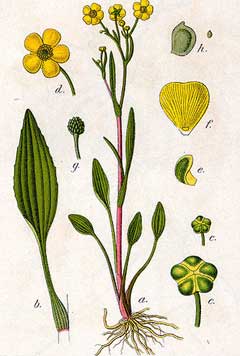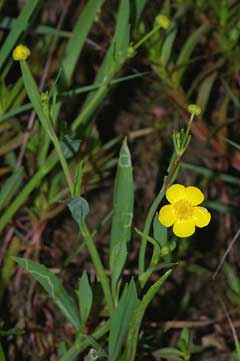 |
|
http://commons.wikimedia.org/wiki/File:Ranunculus_flammula_Sturm45.jpg |
 |
| http://commons.wikimedia.org/wiki/User:Fice |
Translate this page:
Summary
Physical Characteristics

 Ranunculus flammula is a PERENNIAL growing to 0.6 m (2ft).
Ranunculus flammula is a PERENNIAL growing to 0.6 m (2ft).
See above for USDA hardiness. It is hardy to UK zone 5. It is in flower from May to September. The species is hermaphrodite (has both male and female organs) and is pollinated by Flies, bees. The plant is self-fertile.
Suitable for: light (sandy), medium (loamy) and heavy (clay) soils. Suitable pH: mildly acid, neutral and basic (mildly alkaline) soils. It can grow in semi-shade (light woodland) or no shade. It prefers moist or wet soil and can grow in water.
UK Hardiness Map
US Hardiness Map
Synonyms
Plant Habitats
Pond; Bog Garden;
Edible Uses
References More on Edible Uses
Medicinal Uses
Plants For A Future can not take any responsibility for any adverse effects from the use of plants. Always seek advice from a professional before using a plant medicinally.
The whole plant is strongly rubefacient[4]. A tincture of the plant is used to cure ulcers[4].
References More on Medicinal Uses
The Bookshop: Edible Plant Books
Our Latest books on Perennial Plants For Food Forests and Permaculture Gardens in paperback or digital formats.

Edible Tropical Plants
Food Forest Plants for Hotter Conditions: 250+ Plants For Tropical Food Forests & Permaculture Gardens.
More

Edible Temperate Plants
Plants for Your Food Forest: 500 Plants for Temperate Food Forests & Permaculture Gardens.
More

More Books
PFAF have eight books available in paperback and digital formats. Browse the shop for more information.
Shop Now
Other Uses
References More on Other Uses
Cultivation details
A plant of boggy soils and shallow water, it prefers a loamy soil and a sunny position. A greedy plant, inhibiting the growth of nearby plants, especially legumes[54].
References Carbon Farming Information and Carbon Sequestration Information
Temperature Converter
Type a value in the Celsius field to convert the value to Fahrenheit:
Fahrenheit:
The PFAF Bookshop
Plants For A Future have a number of books available in paperback and digital form. Book titles include Edible Plants, Edible Perennials, Edible Trees,Edible Shrubs, Woodland Gardening, and Temperate Food Forest Plants. Our new book is Food Forest Plants For Hotter Conditions (Tropical and Sub-Tropical).
Shop Now
Plant Propagation
Seed - sow spring in situ. This plant does not really need any encouragement. Division in spring. Very easy, larger divisions can be planted out direct into their permanent positions. We have found that it is better to pot up the smaller divisions and grow them on in light shade in a cold frame until they are well established before planting them out in late spring or early summer.
Other Names
If available other names are mentioned here
Native Range
TEMPERATE ASIA: Turkey, Russian Federation (Altay) NORTHERN AMERICA: Canada (Northwest Territories, Yukon, Québec, Nova Scotia, Ontario, Prince Edward Island, New Brunswick, Newfoundland and Labrador, Saskatchewan, Alberta, Manitoba, British Columbia), St. Pierre and Miquelon, United States (Alaska, Connecticut, Maine, Massachusetts, Michigan, New Hampshire, New Jersey, New York, Pennsylvania, Vermont, Minnesota, North Dakota (north), Wisconsin, Colorado, Idaho, Montana (west), Oregon, Washington, Wyoming (west), New Mexico (northwest), Arizona (north), California, Nevada) EUROPE: Denmark, Finland, United Kingdom, Ireland, Norway, Sweden, Austria, Belgium, Switzerland, Czech Republic, Germany, Hungary, Netherlands, Poland, Slovakia, Russian Federation (European part), Belarus, Estonia, Lithuania, Latvia, Ukraine (north), Albania, Bulgaria, Bosnia and Herzegovina, Greece (north), Croatia, Italy (incl. Sardinia, Sicily), North Macedonia, Montenegro, Romania, Serbia, Slovenia, Spain, France (incl. Corsica), Portugal AFRICA: Portugal (Azores, Madeira Islands), Algeria (north), Morocco
Weed Potential
Right plant wrong place. We are currently updating this section.
Please note that a plant may be invasive in one area but may not in your area so it's worth checking.
Conservation Status
IUCN Red List of Threatened Plants Status :

| Related Plants
|
| Latin Name | Common Name | Habit | Height | Hardiness | Growth | Soil | Shade | Moisture | Edible | Medicinal | Other |
| Ranunculus acris | Meadow Buttercup, Tall buttercup, Showy buttercup | Perennial | 1.0 |
0-0
| | LMH | SN | MWe | 1 | 2 | 0 |
| Ranunculus aquatilis | Water Crowfoot, White water crowfoot | Annual/Perennial | 0.0 |
4-8
| | LMH | SN | MWeWa | 1 | 1 | |
| Ranunculus arvensis | Corn Buttercup | Annual | 0.5 |
0-0
| | LMH | SN | M | 0 | 1 | 0 |
| Ranunculus bulbosus | Bulbous Buttercup, St. Anthony's turnip | Perennial | 0.3 |
0-0
| F | LMH | SN | M | 1 | 2 | 0 |
| Ranunculus californicus | California Buttercup | Perennial | 0.6 |
6-9
| | LMH | SN | M | 1 | 0 | |
| Ranunculus chinensis | Hui Hui Suan | Perennial | 0.6 |
-
| | LMH | SN | MWe | 1 | 0 | |
| Ranunculus ficaria | Lesser Celandine - Pilewort, Fig buttercup | Perennial | 0.2 |
0-0
| F | LMH | SN | M | 1 | 2 | 3 |
| Ranunculus hirtus | | Perennial | 0.0 |
-
| | LMH | SN | M | 0 | 1 | |
| Ranunculus inamoeus | Graceful Buttercup | Perennial | 0.3 |
-
| | LMH | SN | M | 1 | 0 | |
| Ranunculus japonicus | Mao Gen | Perennial | 0.1 |
-
| | LMH | SN | M | 1 | 1 | |
| Ranunculus kochii | | Perennial | 0.1 |
5-9
| | LMH | N | M | 1 | 0 | |
| Ranunculus muricatus | Rough-Seed Buttercup, Spinyfruit buttercup | Annual | 0.3 |
0-0
| | LMH | SN | M | 0 | 1 | |
| Ranunculus nipponicus | | Perennial | 0.0 |
-
| | LMH | SN | WeWa | 1 | 0 | |
| Ranunculus occidentalis | Western Buttercup | Perennial | 0.6 |
-
| | LMH | SN | M | 1 | 0 | |
| Ranunculus pallasii | Buttercup, Pallas' buttercup | Perennial | 0.1 |
0-0
| | LMH | SN | MWe | 1 | 0 | |
| Ranunculus pennsylvanicus | Pennsylvania Buttercup | Annual/Perennial | 1.0 |
-
| | LMH | SN | MWe | 1 | 1 | 2 |
| Ranunculus quelpaertensis | | Perennial | 0.6 |
-
| | LMH | SN | MWe | 1 | 0 | |
| Ranunculus repens | Creeping Buttercup, Prairie Double-flowered Buttercup, Water Buttercup, Creeping Buttercup | Perennial | 0.3 |
3-8
| F | LMH | SN | M | 1 | 1 | 0 |
| Ranunculus reptans | Creeping Spearwort | Perennial | 0.2 |
-
| F | LMH | SN | MWe | 1 | 0 | |
| Ranunculus rivularis | | Perennial | 0.0 |
-
| | LMH | SN | M | 0 | 1 | |
| Ranunculus sceleratus | Celery-Leaved Buttercup, Cursed buttercup | Perennial | 0.6 |
0-0
| | LMH | SN | MWeWa | 1 | 1 | 1 |
| Ranunculus tachreoi | | Perennial | 1.0 |
-
| | LMH | SN | M | 1 | 0 | |
| Ranunculus ternatus | | Perennial | 0.3 |
-
| | LMH | SN | M | 0 | 1 | |
|
Growth: S = slow M = medium F = fast. Soil: L = light (sandy) M = medium H = heavy (clay). pH: A = acid N = neutral B = basic (alkaline). Shade: F = full shade S = semi-shade N = no shade. Moisture: D = dry M = Moist We = wet Wa = water.
Now available:
Food Forest Plants for Mediterranean Conditions
350+ Perennial Plants For Mediterranean and Drier Food Forests and Permaculture Gardens.
[Paperback and eBook]
This is the third in Plants For A Future's series of plant guides for food forests tailored to
specific climate zones. Following volumes on temperate and tropical ecosystems, this book focuses
on species suited to Mediterranean conditions—regions with hot, dry summers and cool, wet winters,
often facing the added challenge of climate change.
Read More
Expert comment
Author
L.
Botanical References
17200
Links / References
For a list of references used on this page please go here
Readers comment
© 2010, Plants For A Future. Plants For A Future is a charitable company limited by guarantee, registered in England and Wales. Charity No. 1057719, Company No. 3204567.